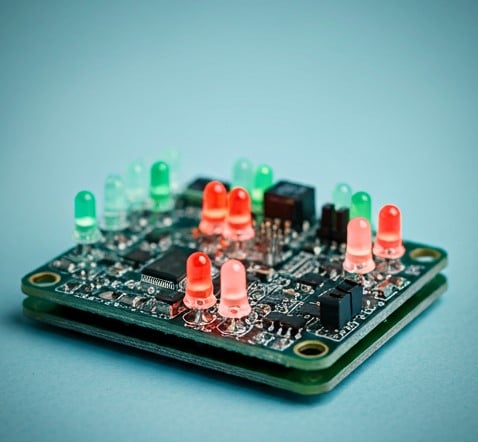Various industries are now using LEDs or Light Emitting Diodes for lighting purposes. These solid-state lighting devices convert electricity into light whencurrent passes through the semiconductor junctions of the LEDs. Compared to traditional light bulbs, LEDs are far more efficient, as they can convert more than 80% of the input energy to light. They are also longer lasting than most other types of light bulbs. Their environmental friendliness and small size add to their advantage.
At Rush PCB Inc., we offer LED PCBs or printed circuit boards that we design expressly for mounting LEDs. Our LED PCBs are thin boards that provide physical support for the LEDs, and further help by transferring heat away from the LED bulbs. Our boards enhance the performance of the LEDs mounted on them and prevent damage to them.
Our LED PCBs, also known as MCPCBs or Metal Core PCBs, have brought great progress to the LED industry. They have been instrumental in increasing the lifespan of the LEDs while enhancing their performance significantly.
Why LED PCBs?
Although LEDs are highly efficient in converting electricity to light, they generate some heat when operating at high power. Unless this heat is removed quickly, it may cause thermal runaway, thereby destroying the LED. The metal core in the LED PCB helps to distribute the heat very quickly.
LED applications in industries prefer to use metal core LED PCBs as the metal core has a higher ability to dissipate the heat from the LEDs, keeping them operating within their specified temperature range. We typically use Aluminum as the metal core for LED PCBs.
Metal in LED PCBs
We make metal-core PCBs using copper, aluminum, or stainless steel. This is because the higher thermal conductivity of these metals helps in removing heat faster. While copper offers the highest thermal conductivity, it is also more expensive. Users, therefore, prefer aluminum instead, as it offers a good compromise between performance and cost.
Aluminum also offers higher versatility. We use different types of aluminum for various purposes, thereby providing specialized LED PCBs. All these aluminum types are highly effective and they offer good results:
▪ Flexible Aluminum
We use flexible aluminum as it offers great insulation and flexibility. A combination of ceramic fillers and Polyimide resins provide the insulation. The combination allows us to offer high thermal conductivity along with good flexibility.
▪ Hybrid Aluminum
Merging aluminum with a non-thermal material like FR4 offers high thermal conductivity along with high rigidity.
▪ Multi-Layer Aluminum
We use multi-layer aluminum for highly complex PCBs, as it is an excellent choice for high thermal conductivity, outstanding insulation, and good mechanical strength. These PCBs typically have more than two layers made of thermally conductive adhesives.
Aluminum LED PCB Construction
These are the most popular types of LED PCBs. The substrate sits on an aluminum alloy base, mostly made from an alloy of aluminum, magnesium, and silicon. We alter the properties of the materials to meet individual application needs. Typically, these PCBs consist of several layers:
▪ Base Layer
The base layer is the aluminum alloy sheet, on which the rest of the PCB rests. Being highly heat-conducting, it distributes the heat and disperses it.
▪ Thermal Insulation
This layer is made of a ceramic polymer, protecting the board from thermal and mechanical damage. As the circuit operates, this layer absorbs heat from the LED and transfers it to the base or aluminum layer.
▪ Circuit Layer
This layer has the copper circuit laid out according to the circuit design of the LED PCB.

Advantages of Aluminum for LED PCBs
Using Aluminum for LED PCBs offers many benefits like:
Lower Costs
As aluminum is abundantly available around the world and is relatively easy to
mine and refine, it is less expensive compared to other types of metals. We
use aluminum for PCBs as it is a cheaper alternative compared to other
methods of transferring heat, such as using heat sinks. Using aluminum
reduces the overall cost of producing our customers’ boards.
Enhanced Environmental Performance
As aluminum is non-toxic and can be recycled, it offers an enhanced
environmental performance—it shrinks the carbon footprint of producing the
PCB. Aluminum is also easier and safer to dispose of at the end of the LED PCB’s life.
Improved Durability
A backing of aluminum makes the fiberglass or ceramic PCB more durable and
more resistant to damage during manufacturing, assembly, and use. The
aluminum backing improves the LED PCB’s durability, allowing them to be used in harsher environments.
Reduced Weight
As aluminum is lighter than other alternatives like copper and stainless steel, it is easier and cheaper to handle and ship aluminum LED boards. The
combination of lightweight, higher reliability, and robustness makes aluminum LED boards ideal for use in vehicles and aerospace.
Types of LED PCBs
We use SMD or surface mount device LEDs or COB or chip-on-board LEDs on
most of our LED PCBs. We mount SMD LEDs on the surface of the board along with other SMD components. For COB LEDs, we arrange the dies or ICs in a circle or a regular polygon and directly bond them to the PCB, sealing them together with glue. Then we use either flip-chip or wire bonding to bond the COB LEDs to the PCB.
LED PCB Assembly Process
Assembling an LED PCB involves mounting all the necessary electronic
components including the LEDs on the PCB.
SMD LEDs
For SMD-type LEDs, we mount them along with other SMT components on the board. For this, we follow the regular process:
- Silkscreen printing the solder paste on the PCB
- Solder paste inspection
- Component placement on the PCB
- Reflow soldering to bond the components onto the PCB
- Automated optical inspection
COB LEDs
For COB-type LEDs, we directly bond them to the PCB without surface mount
or reflow soldering. For bonding, we use one of two processes:
Wire Bonding
We use gold wires to connect the chips to the positive and negative electrode
pads.
Flip-Chip
Flip-chip COB LEDs typically have solder balls at their bottoms. After placing
them on the PCB, we use force and high temperature to allow the solder balls
to melt, thereby bonding the chip to the PCB. We then use an encapsulation
glue to seal the COB LEDs to the PCB.
Through-Hole LEDs
Through-hole assembly requires passing component leads through holes in the
PCBs and soldering the leads onto copper pads. Although providing stronger
and more durable connections, this method is no longer as popular as using
SMD LEDs.
Why Rush PCB Inc. for LED PCB Assembly?
If you want to take full advantage of all the benefits that LED PCBs have to
offer, come to Rush PCB Inc., as we have decades of experience in fabricating
and assembling LED PCBs. Lights from LEDs are rather temperature-sensitive
and require complex circuit designs to compensate. We offer the necessary
expertise and world-class equipment for fabricating and assembling LED PCBs. We have been working with LED lighting since the early days of the
technology, and we have the necessary knowledge and skills to help you with
your LED project.









